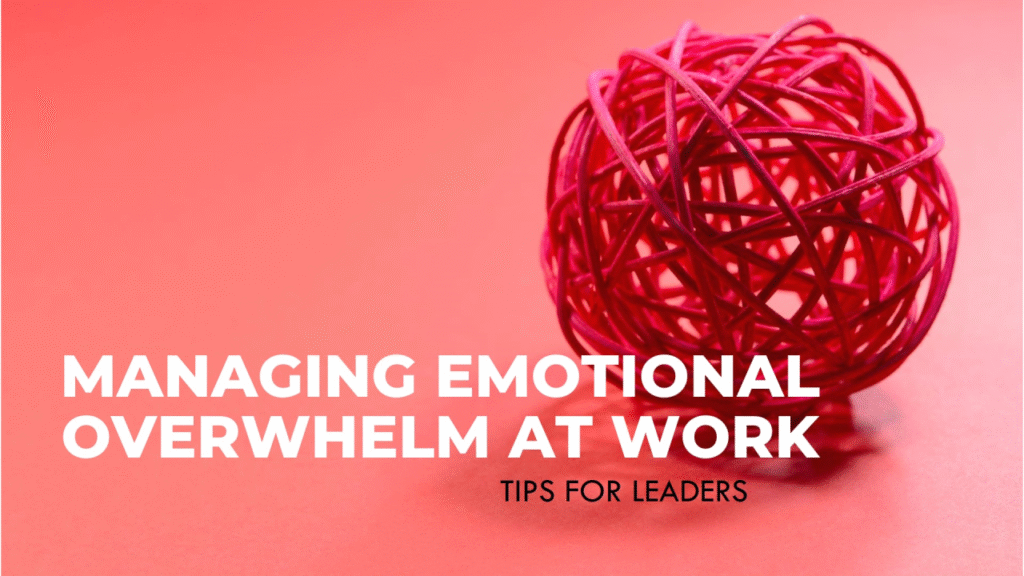How Leaders Can Deal With Emotional Overwhelm at Work

In the ever-demanding world of leadership, emotional overwhelm is an unspoken yet common companion. Leaders juggle high-stakes decisions, complex team dynamics, and relentless expectations—often leaving little room to process their own emotions. While the image of a leader often evokes stoicism and control, the truth is that leaders, like everyone else, are human. They feel the weight of challenges, the sting of setbacks, and the emotional toll of managing people and processes.
The question is not whether leaders will face emotional overwhelm but how they will navigate it.
Understanding Emotional Overwhelm
Emotional overwhelm occurs when the sheer volume or intensity of emotions becomes too much to process effectively. It can be triggered by a challenging work situation, such as a high-pressure deadline, a conflict within the team, or even a personal issue spilling over into professional life. For leaders, the stakes are higher because their emotional state can influence their decisions, the team’s morale, and the overall workplace culture.
Unchecked, emotional overwhelm can lead to burnout, strained relationships, and poor decision-making. But when managed thoughtfully, it can become a source of growth and resilience.
Strategies for Leaders to Manage Emotional Overwhelm
1. Pause and Acknowledge
Leadership often comes with the pressure to appear composed at all times. However, denying or suppressing emotions only intensifies overwhelm. The first step is to pause and acknowledge what you’re feeling. Ask yourself:
• What am I feeling right now?
• What triggered this emotion?
• Is this a reaction to something immediate, or is it compounded by other stressors?
Naming your emotions (e.g., frustration, fear, or sadness) helps diffuse their intensity and gives you clarity on how to address them.
2. Prioritize Ruthlessly
Overwhelm often stems from a sense of “too much to do, too little time.” Take a moment to triage your tasks. Ask:
• What truly requires my attention right now?
• What can be delegated or delayed?
By focusing on what’s essential, you create mental space to tackle challenges more effectively.
3.Practice Self-Compassion
Many leaders hold themselves to impossible standards, amplifying feelings of inadequacy or guilt when things don’t go as planned. Practicing self-compassion means treating yourself with the same kindness you would offer a struggling colleague. Remind yourself that making mistakes or feeling overwhelmed is part of being human—and part of being a leader.
4.Create Micro-Moments of Recovery
Emotional overwhelm often thrives in a nonstop work environment. Even short breaks can reset your emotional state. These micro-moments might include:
• Taking a 5-minute walk.
• Practicing mindful breathing for 2 minutes.
• Journaling your thoughts to declutter your mind.
These small acts can create a big difference in how you manage your emotions throughout the day.
5.Leverage Emotional Awareness as a Leadership Strength
Instead of seeing emotional overwhelm as a weakness, view it as an opportunity to deepen your emotional intelligence (EQ). By becoming more attuned to your emotions, you can:
• Recognize and respond to your team’s emotional needs more effectively.
• Lead with empathy and authenticity, creating a culture of psychological safety.
• Build stronger, trust-based relationships.
6. Seek Support
Leaders often feel they must shoulder the burden alone, but this mindset can be isolating. Reaching out to a mentor, coach, or trusted colleague can provide a fresh perspective and emotional support. Sometimes, simply articulating what you’re going through can ease the intensity of the overwhelm.
Transforming Overwhelm into Resilience
Leadership isn’t about avoiding challenges or emotions—it’s about navigating them with wisdom and grace. Emotional overwhelm, when approached mindfully, can become a powerful teacher. It can help you discover your boundaries, refine your priorities, and deepen your empathy for others.
Remember, your ability to manage your emotions doesn’t just impact you; it sets the tone for your team. When you model emotional awareness and resilience, you create an environment where others feel empowered to do the same.
Key Takeaways
1. Acknowledge and name your emotions to reduce their intensity.
2. Prioritize tasks and delegate to free up mental bandwidth.
3. Practice self-compassion and accept imperfection as part of leadership.
4. Take micro-breaks to reset your emotional state.
5. Seeksupport from trusted mentors or colleagues to gain perspective.
Leadership is not about being invincible but about being human—and showing others that it’s okay to do the same.How do you navigate emotional overwhelm as a leader? Share your thoughts and strategies below—we’d love to hear from you.